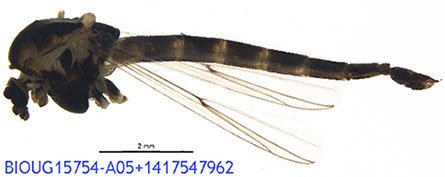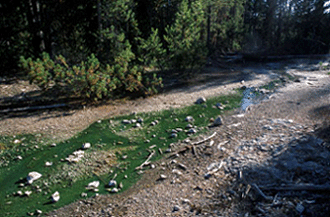Species 4j. Chironomus acerbiphilus Tokunaga, 1939Synonym: C. crassimanus Strenzke, 1959.In BOLD Bin: BOLD:AAL9507.
Nearest neighbor Bin: BOLD:AAJ4234
This bin contains the Japanese specimens of C. acerbiphilus Adult:
The adult male is known only from the photograph of an incomplete male from the BOLD database (below).

Wing length about 3.8 mm; wings clear unmarked, anterior veins darker.
Coloration generally dark, thorax dark yellow grey; vittae, postnotum and metanotum dark, almost black; scutellum dark yellowish. Abdominal tergites mostly blackish with a thin paler band distal on segments II-VI.Pupa: The pupae of North American populations are not known but the pupa of C. crassimanus from Europe has been described by Langton & Visser 2003 and Rodrigues et al. 2009).
Length of exuvia 6.7-10.0 mm long.
Coloration golden brown to brown, contrast between thorax and abdomen not clearly marked.
Cephalic tubercle conical 70-120 µm x 55-67 µm; frontal setae 38-40 µm long. Basal ring of thoracic horn 140-180 µm long by 60-90 µm wide (HR 2.0-2.4). Anterior thorax more sparsely granulate; granulation grading into reticulation sooner: above the oblique hinge line towards scutal hump evanescent and below, reticulate.
Hook row entire occupying 0.41 of segment width; 42-66 hooks. Pedes spurii B well developed on segment II. Neither description considers the Pedes spurii A of segment IV.
Armament of tergites II-VI in the form of an undivided patch of strong points, not strongly waisted and e.g. on tergite III extending laterally at most only as far as the inner edge of the lateral of the anterior adhesion marks and setae D4. The posterior transverse band not successively increasing in extent to tergite VI; usually reduced on VI, the most posterior points of tergites IV and V short.
Conjunctives IV/V and V/VI less strongly armed, rarely the points spinulate.Postero-lateral spur of segment VIII with 1-4 long-acuminate spines. Anal lobes weakly rounded; fringe with 67-116 taeniae. Fourth instar larva a small to medium sized plumosus-type larva. Lateral tubules turn ventrally as described by Sasa (1978) for Japanese specimens. Ventral tubules well developed.
Head generally brownish; gula very dark over posterior half to two thirds, frontoclypeus darkened, and also some darkening along outside edge of frontoclypeus.
Oesophageal opening about 76 µm long and 5 times longer than wide.
C1 tooth of mentum relatively broad, with c2 teeth well separated and sharp (type IB); lateral teeth sharp, 4th laterals hardly reduced (type I), but 5th laterals slightly above the graduated level of the other lateral teeth; 6th laterals arising slightly lower than 6th laterals and slightly turned out. Sasa (1978) shows small notches near the tip of the center tooth, but these will only be seen if the mentum is not worn.
Ventromental plates abt 3.7-4.0 times wider than deep and 1.2 times the mentum width, IPD about 39-40% of mentum width; with about 38 striae; VMR about 0.31. Pecten epipharyngis with about 16-19 sharp graded teeth (type B).
Antenna with basal segment relatively short only about 0.3 of VHL, about 2.5-3 times longer than wide; Ring organ about middle of segment; AR about 2.17; segment 3 quite short, shorter than segment 5; relative length of segments (µm) 110 : 28 : 7 : 10 : 8.
Distance between antennal bases about the same or slightly wider than the distance between the S4 setae, which occupy about 0.78 of the FC width at that point.
Premandibles with outer tooth slightly longer (when not worn); inner tooth about 2-4 times wider than outer tooth.
Mandiblewith 3rd inner tooth defined and darkened (type IIIB-C), at least 12 furrows on outer surface near the base; about 11 taeniae in Pecten mandibularis; Mdt-Mat about 23 µm; MTR about 0.32-0.4. Cytology: 4 polytene chromosomes with the pseudothummi-cytocomplex combination AE, BF, CD, G.
Centromeres strongly heterochromatic and constricted. Pairing may occur betwen the centromeres of different chromosomes. Arm G mostly paired, with BR near middle of arm and no nucleolus. Nucleolus developed in arm A.
A fixed asymmetrical pericentric inversion occurs on chromosome CD, transferring the proximal bands of arm D into arm C, or alternatively it may be a duplication of the CD centromere region reported in other pseudothummi-cytocomplex species such as C. alpestris (Wülker, pers. comm.; Kiknadze et al. 2008, as C. dorsalis).
No polymorphism in studied North American, European or Japanese populations.
aceA1: 1a-i, 7 - 9, 2d - 3, 12 - 10, 2c - 1k, 6 - 4, 13 - 19 with large nucleolus in segment 13-15.
aceB1: banding not clear, but probably 22-28 near centromere.
aceC1: 1 - 2, 10 - 3, 11 - 16, 22, 24 - 21, D(see below) (Jablonska-Barna et al. 2010).
aceD1: 1 - 3, 6 - 4, 7 - 9, 18f-a, 13 - 10, 17 - 14, 18g - 20 (Jablonska-Barna et al. 2010).
aceE1: 1 - 3e, 10b - 3f, 10c - 13 ie. as acidophilus, frommeri, whitseli, etc.
Jablonska-Barna et al. also consider the arm as identical to the aprilinus sequence but list a proximal inv. 13-11.
aceF1: 1-7, 17-16, 11-14a, 15-14b, 4-6, 9-8, 1-3, 10, 18-20 (clarified from Jablonska-Barna et al. 2010)
aceG1: BR near middle of arm. In acidic waters (pH3), and also elevated temperatures (35C, with some up to 45C) in North America.
Nymph Creek, YNP, Wyoming. (courtesy Kathy Sheehan)DNA sequence: MtCOI sequence is in the BOLD database. Sequence of Japanese specimens are also in GenBank and/or BOLD database. BOLD places them in a separate Bin (BOLD:AAJ4234). This could simply be due to geographic isolation, but the differences in color and the fact that the Japanese specimens have a different nearest-neighbor Bin, suggest that they may be different species. Base differences USA A A T G G T T TA A T T C T A T T A C A C G G T A C T T G G A T G T A Japan G G A A AC C C G GC C T C G C C G T T T A AA G T C A A A T C A C G |

